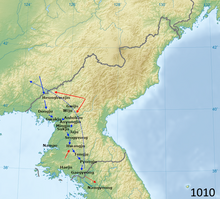Second conflict in the Goryeo–Khitan War
| Second Goryeo–Khitan War | |||||||
|---|---|---|---|---|---|---|---|
| Part of Goryeo-Khitan Wars | |||||||
 | |||||||
| |||||||
| Belligerents | |||||||
| Goryeo | Liao dynasty | ||||||
| Commanders and leaders | |||||||
|
Kang Cho† Yang Kyu† Kim Suk-hŭng† Tae To-su (POW) Ha Kong-jin |
Emperor Shengzong Xiao Baiya[5] | ||||||
| Strength | |||||||
| 400,000[5] | |||||||
| Casualties and losses | |||||||
| Severe, main force annihilated | 15,000< | ||||||
The Second Goryeo-Khitan War (Chinese: 第二次高麗契丹戰爭; Korean: 제2차 고려-거란 전쟁) was an 11th-century conflict between the Goryeo dynasty of Korea and the Khitan-led Liao dynasty of China near what is now the border between China and North Korea. It was the second of the Goryeo-Khitan Wars, with the First Goryeo-Khitan War occurring in 993, the second in 1010, and the third in 1018.
When King Seongjong died in 997, the Liao dynasty invested his successor Wang Song as king of Goryeo (King Mokjong, r. 997-1009).[6] In 1009, he was assassinated by the forces of the general Kang Cho.[7] Using it as a pretext, the Liao attacked Goryeo in the next year.[8] They lost the first battle but won the second one, and Kang Cho was captured and killed. The Liao army occupied several border prefectures to the north. The Goryeo king offered to surrender but the governor of Kaesong, the capital of Goryeo, killed the Liao envoys and opted to resist.[5] The Liao won a pitched battle at Kaesong and occupied the city,[1][9][10] however the Goryeo king had already escaped to Naju.[2] Kaesong was sacked and its palaces, official buildings, and archives were destroyed. The Goryeo king fled to the south and his armies regrouped. The Liao began their withdraw but the surrendered districts rose up against them. Mired down in the mountains during the winter, the Liao forces were forced to abandon most of their armour and weapons before retreating north of the Yalu. Afterward Goryeo promised to reaffirm its tributary relationship with the Liao dynasty.[3][4] The Goryeo king sued for peace, but the Liao emperor demanded that he come in person and also cede key border areas; the Goryeo court refused the demands, resulting in a decade of hostility between the two nations, during which both sides fortified their borders in preparation of war.[4][11] Liao attacked Goryeo in 1015, 1016, and 1017, but the results were indecisive.[12]
See also
[edit]- Goryeo–Khitan War
- First conflict in the Goryeo–Khitan War
- Second conflict in the Goryeo–Khitan War
- Third conflict in the Goryeo–Khitan War
Notes
[edit]- ^ a b Simons 1995, p. 95: "a prelude to more invasions during the reign of King Hyonjong (1010-1031) and the occupation of Kaesong, the Koryo capital."
- ^ a b Nahm 1988, p. 89.
- ^ a b Simons 1995, p. 93: "a second Liao incursion resulted in heavy losses, the sacking of Kaesong, and the imposition of Liao suzerainty over the Koryo state."
- ^ a b c Twitchett, Denis C.; Franke, Herbert; Fairbank, John King (1978). The Cambridge History of China: Volume 6, Alien Regimes and Border States, 907-1368. Cambridge University Press. p. 111. ISBN 9780521243315. Retrieved 30 July 2016.
- ^ a b c Twitchett & Tietze 1994, p.111.
- ^ Twitchett & Tietze 1994, p.104.
- ^ Hyun 2013, p. 191.
- ^ Twitchett & Tietze 1994, p. 111: "The Khitan sent an expeditionary army ... to punish the murderer of their former vassal".
- ^ Hatada, Smith Jr & Hazard 1969, p. 52: "in the reign of King Hyŏnjong (1010-1031) there were numerous Khitan invasions, and even the capital Kaesŏng was occupied."
- ^ Ebrey & Walthall 2014, [1], p. 171, at Google Books: "In 1010, on the pretext that the rightful king had been deposed without the approval of the Liao court, the Khitan emperor personally led an attack that culminated in the burning of the Goryeo capital."
- ^ Simons 1995, p. 93: "a second Liao incursion resulted in heavy losses, the sacking of Kaesong, and the imposition of Liao suzerainty over the Koryo state." p. 95: "a prelude to more invasions during the reign of King Hyonjong (1010-1031) and the occupation of Kaesong, the Koryo capital."
- ^ Twitchett, Denis C.; Franke, Herbert; Fairbank, John King (1978). The Cambridge History of China: Volume 6, Alien Regimes and Border States, 907-1368. Cambridge University Press. p. 111. ISBN 9780521243315. Retrieved 30 July 2016.
From 1015 to 1019 there was incessant warfare, with attacks on Koryŏ in 1015, 1016, and 1017 in which victory went sometimes to Koryŏ, sometimes to the Khitan, but in sum were indecisive.
References
[edit]- Ebrey, Patricia Buckley; Walthall, Anne (2014), Pre-Modern East Asia: To 1800: A Cultural, Social, and Political History, Third Edition, Boston, MA: Wadsworth, Cengage Learning, ISBN 978-1-133-60651-2.
- Hatada, Takashi; Smith Jr, Warren W.; Hazard, Benjamin H. (1969), A History of Korea, Santa Barbara, CA: ABC-Clio, ISBN 0-87436-064-1.
- Hyun, Jeongwon (2013), Gift Exchange among States in East Asia during the Eleventh Century (Thesis (Ph.D.)), University of Washington, hdl:1773/24231.
- Simons, Geoff (1995), Korea: The Search for Sovereignty, New York, NY: St. Martin's Press, ISBN 0-312-12531-3.
- Twitchett, Denis; Tietze, Klaus-Peter (1994), "The Liao", in Franke, Herbert; Twitchett, Denis (eds.), The Cambridge History of China, Volume 6, Alien Regime and Border States, 907-1368, Cambridge: Cambridge University Press, pp. 43–153, ISBN 0-521-24331-9.
- Nahm, Andrew C. (1988), Korea: Tradition & Transformation: A History of the Korean People, Elizabeth, NJ: Hollym, ISBN 0-930878-56-6.
